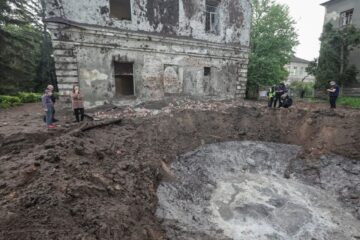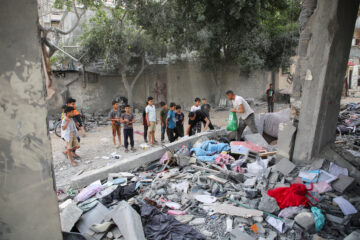“Force Protection Alpha in Effect” –coming to a town near you
By Brian Terrell, WarIsACrime.org
On April 15, 2014, when the story broke on the world that the Central Intelligence Agency’s covert program of assassination by remotely controlled drones is not distinct from the drone program of the U.S. Air Force as we had been told, I was on the “Sacred Peace Walk,” an event sponsored each spring by the Nevada Desert Experience, a 70 mile trek from Las Vegas to the Nevada Nuclear Test Site. Creech Air Force Base is along the way and we had already made plans for a protest there the next morning. While the CIA’s drone program is shrouded in secrecy, the Air Force supposedly has been using drones strictly as a weapon for waging war against combatants in recognized areas of conflict such as Afghanistan and formerly in Iraq, under a chain of command that is accountable to elected officials. Some who condemn the CIA’s assassinations by drones as illegal give a pass to or even laud the Air Force use of drones as a more restrained way to fight war.
This distinction has now been exposed as a lie. In a new documentary film released in Europe, “Drone,” former Air Force drone operators, veterans of a super-secret Squadron 17 at Creech Air Force Base in Nevada, reveal that “it’s always been the Air Force that flies” the CIA’s missions, “the CIA might be the customer, but the Air Force has always flown it.”
The fact that airmen at Creech are carrying out assassination missions and extrajudicial executions far from declared zones of conflict on orders from unknown and unnamable bureaucrats did not come as a surprise. Neither was the news a “game changer” in regard to the actions we had planned, although we quickly revised the indictment listing the war crimes committed at Creech that some of us would attempt to deliver to the base commander.
My arrest at Creech along with eight others on April 16 was a “return to the scene of the crime” (the Air Force’s crime, not mine) for me, as I was among the “Creech 14” in April 2009, the first nonviolent direct action against drones in the U.S. Creech was then one of only a few sites from which drones were controlled by the U.S. and by the United Kingdom, which has a wing of the Royal Air Force stationed there to fly their own drones. Since then the use of armed drones has been proliferating around the world and so has the number of drone operation bases in communities around the U.S. My work with Voices for Creative Nonviolence has brought me to the scenes of the crime in Afghanistan, the CIA headquarters at Langley, Virginia and at the gates of drone bases in New York, Iowa, Missouri and in England as well.
The latest revelation is but the exposure of one more lie, one more layer of criminality and venality of this corrupt and dangerous program. Over the years since April 2009, the promises of a new era of better war through drone technology have been steadily unravelling, each of them proving false. It is increasingly clear that rather than limiting the scope of war, drones are expanding and proliferating it, killing more civilians both on battlefields and far from them, endangering our soldiers and the safety of our communities. Instead of keeping the horrors of war at a safe distance, drones bring the war home in unprecedented ways.
President Obama, in an address before the National Defense University May 23, 2013, described this new technology as more precise and by implication more humane than other weaponry: “By narrowly targeting our action against those who want to kill us and not the people they hide among, we are choosing the course of action least likely to result in the loss of innocent life.” There is an understandable appeal to the idea of a weapon that can discriminate between the good and the bad people and limit regrettable “collateral damage.” It is understandable too, that a nation weary of sending its sons and daughters to fight on battlefields far away, risking injury, death or the debilitating effects of posttraumatic stress, might look to embrace a new method of war whereby the warriors fights battles from safe distances. Thousands of miles beyond the reach of the enemy, drone combatants often do not even have to leave their hometowns and are able to return to homes and families at the end of a shift.
In his National Defense University speech, the president contended that “conventional airpower and missiles are far less precise than drones, and likely to cause more civilian casualties and local outrage.” A few weeks later a study published by the same National Defense University refuted his claim. Drone strikes in Afghanistan, the study found, were “an order of magnitude more likely to result in civilian casualties per engagement.” Despite the president’s assurances to the contrary, drone strikes cause immense “local outrage” in the countries where they happen, turning America’s allies into enemies. "What scares me about drone strikes is how they are perceived around the world," said former commander of US and NATO forces in Afghanistan General Stanley McChrystal. "The resentment created by American use of unmanned strikes … is much greater than the average American appreciates. They are hated on a visceral level, even by people who\’ve never seen one or seen the effects of one."
Former defense secretary Robert M. Gates also warns of the seductive power and precision of armed drones that leads many to perceive war as a “bloodless, painless and odorless” affair. “Remarkable advances in precision munitions, sensors, information and satellite technology and more can make us overly enamored with the ability of technology to transform the traditional laws and limits of war. A button is pushed in Nevada and seconds later a pickup truck explodes in Kandahar.” Defense experts and policy makers, Gates warns, have come to view drone warfare as a “kind of video game or action movie. . . . In reality, war is inevitably tragic, inefficient and uncertain.” General Mike Hostage, chief of the US Air Combat Command, claims that while weaponized drones are useful in assassinations of terror suspects, they are impractical in combat. "Predators and Reapers are useless in a contested environment," Hostage said.
Some enlisted personnel are also questioning the use of drones. Heather Linebaugh, a drone operator for the US Air Force for three years says: “Whenever I read comments by politicians defending the Unmanned Aerial Vehicle Predator and Reaper program – aka drones – I wish I could ask them a few questions. I\’d start with: ‘How many women and children have you seen incinerated by a Hellfire missile?’ And: ‘How many men have you seen crawl across a field, trying to make it to the nearest compound for help while bleeding out from severed legs?’ Or even more pointedly: ‘How many soldiers have you seen die on the side of a road in Afghanistan because our ever-so-accurate UAVs were unable to detect an IED [improvised explosive device] that awaited their convoy?’”
Distance from the battlefield does not isolate soldiers from posttraumatic stress or the moral injury of war. Heather Linebaugh speaks of two friends and colleagues who committed suicide and another former drone operator, Brandon Bryant, said that his work had made him into a “heartless sociopath.” While drone pilots are at a greater distance from their victims than other soldiers, he says, the video feed they watch brings them closer: “Artillery doesn’t see the results of their actions. It’s really more intimate for us, because we see everything.”
The Air Force is relegating much of its drone operations to Air National Guard units in various states, creating virtual war zones in local communities. “In an F-16, your whole mission was to train to go to war,” said a pilot of an Ohio Air Guard wing that made a conversion from fighters to drones. “In this mission, we go to war every day.” Foreign postings of state National Guard units are usually made public, but where in the world these citizen soldiers will be fighting from now on will be shrouded in secrecy, hidden even from their families. Reason and the rules of war both suggest that assassinations and acts of war on sovereign nations carried on by local National Guard units will make their communities into legitimate targets of war.
Drone warfare is based on the lie that war can be made more exact, limited and humane through technology. Our civilian and military authorities, proliferating drone attacks around the globe from more and more American bases, are acting recklessly and in defiance of domestic and international law. They are acting without regard for the safety and wellbeing of our troops, of American civilians or of people in faraway places who otherwise would mean us no harm. Rather than limiting war, being an answer, drones perpetuate and multiply the horrors of war and bring them home into our communities.
As our band of walkers approached Creech Air Force Base on the morning of April 16, we were greeted by a large sign at the gate that read “Force Protection Alpha in Effect,” announcing that the base was in its highest security alert. We were also met by an impressive contingent of military police and sheriff’s officers, heavily armed and some on horseback, which easily exceeded in number our little band that left Las Vegas on foot four days earlier. These public servants were clearly responding to a perceived threat to public safety and so were we. Our purposes were disjointed, though, in that we were at Creech in response to a clear and present danger presented by the murderous crimes of Squadron 17 somewhere in the depth of this desert outpost. The official and ostensible law enforcement squad, on the other hand, was there in response to the threat that a few unarmed citizens might step across an arbitrary and ever shifting line on the pavement.
I write this on my way to Kansas City, where, this weekend, good and faithful friends will go to nearby Whiteman Air Force Base to confront the predator drones based there. A few days later, Voices for Creative Nonviolence and friends will start walking from Boeing corporate headquarters in Chicago (a major drone contractor) 160 miles to Battle Creek, Michigan, where a National Guard unit is poised to begin operating predator drones over far away skies. “Force Protection Alpha” is truly “in Effect” and people in Yemen, Pakistan, and Afghanistan as well as communities in the U.S. and Europe are responding to the emergency.
Brian Terrell is a Co-coordinator of Voices for Creative Nonviolence and lives on a Catholic Worker farm in Maloy, Iowa
Photo credit: John Amidon
The views expressed in this article are the author\’s own and do not necessarily reflect The Times Of Earth\’s editorial policy.










